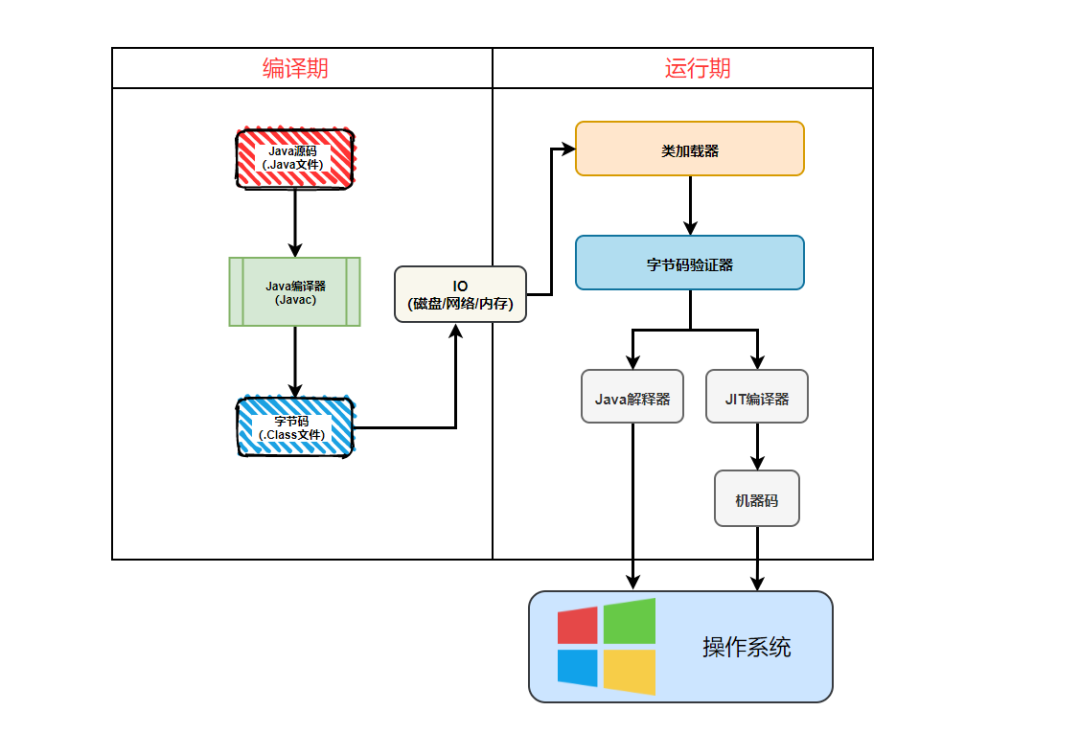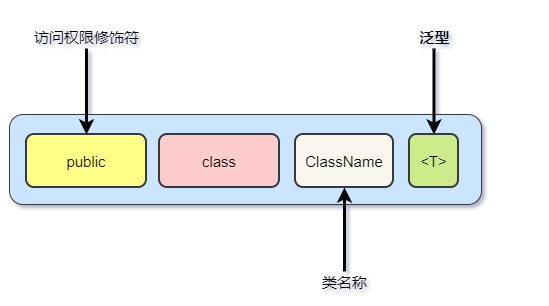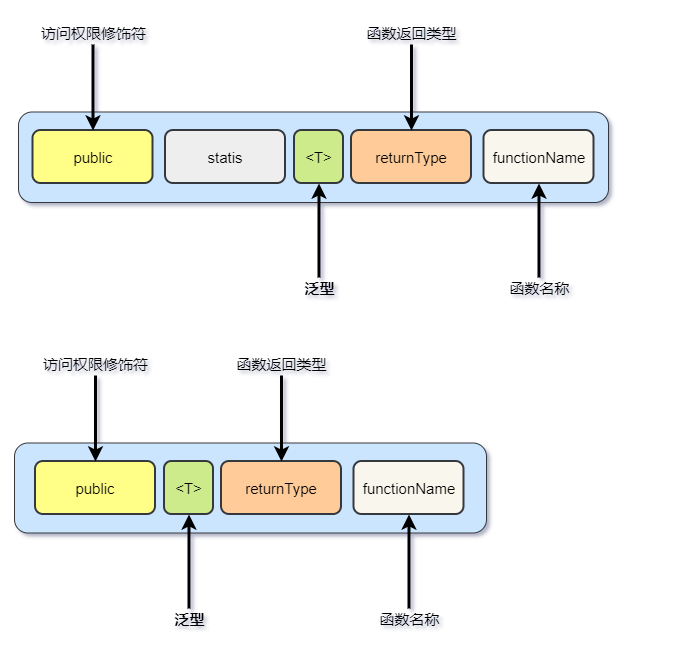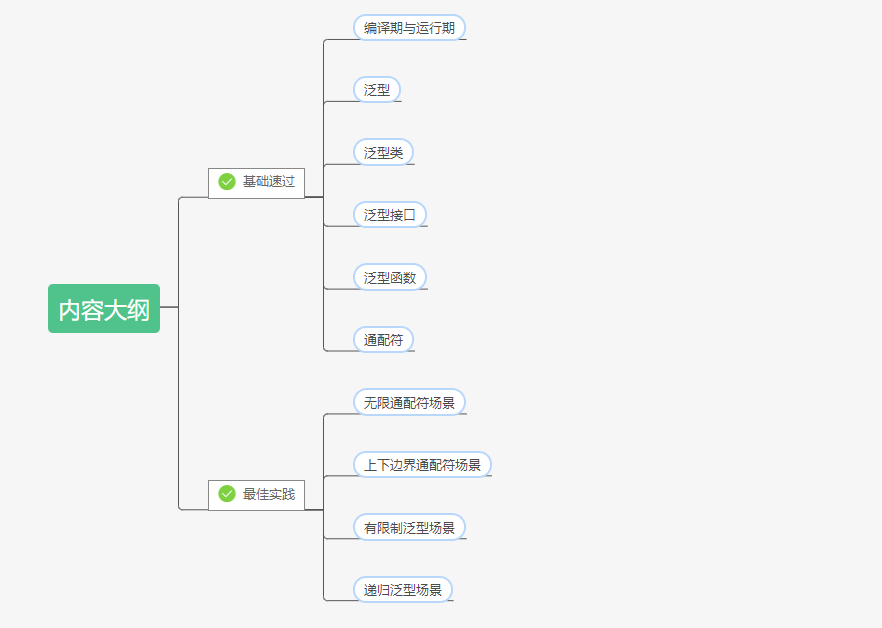Java 泛型
泛型是通用设计上必不可少的元素,所以真正理解与正确使用泛型,是一门必修课!
大纲
基础
因为本文重实践,而且面对的是Java开发人员群体,大家对泛型都有基础,所以泛型基础这块会快速过,帮助大家回忆下即可,后面主要的则重点是通配符
编译期与运行期
编译期是指把源码交给编译器编译成计算机可执行文件的过程,运行期是指把编译后的文件交给计算机执行,直到程序结束。
在Java中就是把.java文件编译成.class文件,再把编译后的文件交给J V M加载执行,如下图
泛型
泛型又叫“参数化类型”,这么抽象的专业词汇不好理解,阿星就用大白话的形式来解释。
人是铁,饭是刚,吃饭是刚需,要吃饭自然就少不了碗筷,但是没有规定碗只能盛饭,除了盛饭它还能盛汤、盛菜,制造者只造这个碗,不关心碗盛什么,具体要盛什么由使用者来决定,这就是泛型的概念。
泛型就是在定义类、接口、方法的时候指定某一种特定类型(碗),让类、接口、方法的使用者来决定具体用哪一种类型的参数(盛的东西)。
Java的泛型是在1.5引入的,只在编译期做泛型检查,运行期泛型就会消失,把这称为“泛型擦除”,最终类型都会变成Object。
在没有泛型之前,从集合中读取到的每一个对象都必须进行类型转换,如果不小心插入了错误的类型对象,在运行时的转换处理就会出错,有了泛型后,你可以告诉编译器每个集合接收的对象类型是什么,编译器在编译期就会做类型检查,告知是否插入了错误类型的对象,使得程序更加安全,也更加清楚。
最后插一句,泛型擦除与原生态类型(List就是原生态,List<T>非原生态)是为了照顾1.5以前设计上的缺陷,为兼容非泛型代码,所作出的折中策略,所以不推荐使用原生态类型,如果使用了原生态类型,就失去了泛型在安全性与描述性方面的优势。
泛型类

类上定义泛型,作用于类的成员变量与函数,代码实例如下
public class GenericClass<T>{//成员变量private T t;public void function(T t){}public T functionTwo(T t){//注意,这个不是泛型方法!!!return t;}}
泛型接口
接口上定义泛型,作用于函数,代码实例如下
public interface GenericInterface<T> {public T get();public void set(T t);public T delete(T t);default T defaultFunction(T t){return t;}}
泛型函数

函数返回类型旁加上泛型,作用于函数,代码实例如下
public class GenericFunction {public <T> void function(T t) {}public <T> T functionTwo(T t) {return t;}public <T> String functionThree(T t) {return "";}}
通配符
通配符是为了让Java泛型支持范围限定,这样使得泛型的灵活性提升,同时也让通用性设计有了更多的空间。
<?>:无界通配符,即类型不确定,任意类型<? extends T>:上边界通配符,即?是继承自T的任意子类型,遵守只读不写<? super T>:下边界通配符,即?是T的任意父类型,遵守只写不读
「通配符限定的范围是体现在确认“参数化类型”的时候,而不是“参数化类型”填充后」,可能这句话不太好理解,来看看下面的代码
/*** 1.创建泛型为Number的List类,Integer、Double、Long等都是Number的子类* new ArrayList<>() 等价于 new ArrayList<Number>()*/List<Number> numberList = new ArrayList<Number>();/*** 2.添加不同子类*/numberList.add(1);//添加Integer类型numberList.add(0.5);//添加Double类型numberList.add(10000L);//添加Long类型/*** 3.创建泛型为Number的List类,Integer、Double、Long等都是Number的子类* 引用是泛型类别是Number,但具体实现指定的泛型是Integer*/List<Number> numberListTwo = new ArrayList<Integer>();//err 异常编译不通过/*** 4.创建泛型为Integer的List类,把该对象的引用地址指向泛型为Number的List*/List<Integer> integerList = new ArrayList<Integer>();List<Number> numberListThree = integerList;//err 异常编译不通过
- 第一步:创建一个泛型为
Number的List,编译器检查泛型类别是否一致,一致编译通过(确认参数化类型) - 第二步:泛型
Number已经填充完毕,调用add函数,此时add入参泛型T已经填充为Number,add可入参Number或其子类 - 第三步:又创建一个泛型为
Number的List,编译器检查泛型类别是否一致,不一致编译失败,提示错误(确认参数化类型) - 第四步:其实与第三步一样,只是做了一个间接的引用(确认参数化类型)
如果要解决上面的编译不通过问题,就需要使用通配符,代码如下
/*** 1.上边界通配符,Number与Number子类*/List<? extends Number> numberListFour = new ArrayList<Number>();numberListFour = new ArrayList<Integer>();numberListFour = new ArrayList<Double>();numberListFour = new ArrayList<Long>();/*** 2.下边界通配符,Integer与Integer父类*/List<? super Integer> integerList = new ArrayList<Integer>();integerList = new ArrayList<Number>();integerList = new ArrayList<Object>();/*** 3. 无界通配符,类型不确定,任意类型*/List<?> list = new ArrayList<Integer>();list = new ArrayList<Number>();list = new ArrayList<Object>();list = new ArrayList<String>();
最后再来说上边界通配符只读不写,下边界通配符只写不读到底是什么意思,用最简单的话来说
<? extends T>上边界通配符不作为函数入参,只作为函数返回类型,比如List<? extends T>的使用add函数会编译不通过,get函数则没问题<? super T>下边界通配符不作为函数返回类型,只作为函数入参,比如List<? super T>的add函数正常调用,get函数也没问题,但只会返回Object,所以意义不大
大家只需要记住上面的规则即可,如果想知道为什么这样设计,可以去了解下P E C S (producer-extends,consumer-super)原则
最佳实践
无限通配符场景
使用泛型,类型参数不确定并且不关心实际的类型参数,就可以使用<?>,像下面的代码
/*** 获取集合长度*/public static <T> int size(Collection<T> list){return list.size();}/*** 获取集合长度-2*/public static int sizeTwo(Collection<?> list){return list.size();}/*** 获取任意Set两个集合交集数量*/public static <T,T2> int beMixedSum(Set<T> s1,Set<T2> s2){int i = 0;for (T t : s1) {if (s2.contains(t)) {i++;}}return i;}/*** 获取任意两个Set集合交集数量-2*/public static int beMixedSumTwo(Set<?> s1,Set<?> s2){int i = 0;for (Object o : s1) {if (s2.contains(o)) {i++;}}return i;}
size与sizeTwo这两个函数都可以正常使用,但是站在设计的角度,sizeTwo会更合适,函数的目标是返回任意集合的长度,入参采用<T>或<?>都可以接收,但是函数本身并不关心你是什么类型参数,仅仅只要返回长度即可,所以采用<?>。beMixedSum与beMixedSumTwo这两个函数比较,道理同上面一样,beMixedSumTwo会更合适,函数的目标是返回两个任意Set集合的交集数量,beMixedSum函数虽然内部有使用到<T>,但是意义不大,因为contains入参是Object,函数本身并不关心你是什么类型参数,所以采用<?>。
忘了补充另一个场景,就是原生态类型,上述代码使用原生态类型函数使用也没问题,但是强烈不推荐,因为使用原生态就丢失了泛型带来的安全性与描述性!!!
上下边界通配符场景
首先泛型是不变的,换句话说List<Object> != List<String>,有时候需要更多灵活性,就可以通过上下边界通配符来做提升。
/*** 集合工具类*/public class CollectionUtils<T>{/*** 复制集合-泛型*/public List<T> listCopy(Collection<T> collection){List<T> newCollection = new ArrayList<>();for (T t : collection) {newCollection.add(t);}return newCollection;}}
上面声明了一个CollectionUtils类,拥有listCopy方法,传入任意一个集合返回新的集合,看似没有什么问题,也很灵活,那再看看下面这段代码。
public static void main(String[] agrs){CollectionUtils<Number> collectionUtils = new CollectionUtils<>();List<Number> list = new ArrayList<>();//list.add....List<Integer> listTwo = new ArrayList<>();//listTwo.add....List<Double> listThree = new ArrayList<>();//listThree.add....List<Number> list1 = collectionUtils.listCopy(list);list1 = collectionUtils.listCopy(listTwo);//err 编译异常list1 = collectionUtils.listCopy(listThree);//err 编译异常}
创建CollectionUtils类,泛型的类型参数为Number,listCopy函数入参的泛型填充为Number,此时listCopy只支持泛型为Number的List,如果要让它同时支持泛型为Number子类的List,就需要使用上边界通配符,再追加一个方法
/*** 集合工具*/public class CollectionUtils<T>{/*** 复制集合-泛型*/public List<T> listCopy(Collection<T> collection){List<T> newCollection = new ArrayList<>();for (T t : collection) {newCollection.add(t);}return newCollection;}/*** 复制集合-上边界通配符*/public List<T> listCopyTwo(Collection<? extends T> collection){List<T> newCollection = new ArrayList<>();for (T t : collection) {newCollection.add(t);}return newCollection;}}public static void main(String[] agrs){CollectionUtils<Number> collectionUtils = new CollectionUtils<>();List<Number> list = new ArrayList<>();//list.add....List<Integer> listTwo = new ArrayList<>();//listTwo.add....List<Double> listThree = new ArrayList<>();//listThree.add....List<Number> list1 = collectionUtils.listCopyTwo(list);list1 = collectionUtils.listCopyTwo(listTwo);list1 = collectionUtils.listCopyTwo(listThree);}
现在使用listCopyTwo就没有问题,listCopyTwo对比listCopy它的适用范围更广泛也更灵活,listCopy能做的listCopyTwo能做,listCopyTwo能做的listCopy就不一定能做了,除此之外,细心的小伙伴肯定发现了,使用上边界通配符的collection在函数内只使用到了读操作,遵循了只读不写原则。
看完了上边界通配符,再来看看下边界通配符,依然是复制方法
/*** 儿子*/public class Son extends Father{}/*** 父亲*/public class Father extends Grandpa{}/*** 爷爷*/public class Grandpa {}/*** 集合工具*/public class CollectionUtils<T>{/*** 复制集合-泛型* target目标 src来源*/public void copy(List<T> target,List<T> src){if (src.size() > target.size()){for (int i = 0; i < src.size(); i++) {target.set(i,src.get(i));}}}}
定义了3个类,分别是Son儿子、Father父亲、Grandpa爷爷,它们是继承关系,作为集合元素,还声明了一个CollectionUtils类,拥有copy方法,传入两个集合,目标集合与来源集合,把来源集合元素复制到目标集合中,再看看下面这段代码
public static void main(String[] agrs){CollectionUtils<Father> collectionUtils = new CollectionUtils<>();List<Father> fatherTargets = new ArrayList<>();List<Father> fatherSources = new ArrayList<>();//fatherSources.add...collectionUtils.copy(fatherTargets,fatherSources);//子类复制到父类List<Son> sonSources = new ArrayList<>();//sonSources.add...collectionUtils.copy(fatherTargets,sonSources);//err 编译异常}
创建CollectionUtils类,泛型的类型参数为Father父亲,copy函数入参的泛型填充为Father,此时copy只支持泛型为Father的List,也就说,只支持泛型的类型参数为Father之间的复制,如果想支持把子类复制到父类要怎么做,先分析下copy函数,copy函数的入参src在函数内部只涉及到了get函数,即读操作(泛型只作为get函数返回类型),符合只读不写原则,可以采用上边界通配符,调整代码如下
/*** 集合工具*/public class CollectionUtils<T>{/*** 复制集合-泛型* target目标 src来源*/public void copy(List<T> target,List<? extends T> src){if (src.size() > target.size()){for (int i = 0; i < src.size(); i++) {target.set(i,src.get(i));}}}}public static void main(String[] agrs){CollectionUtils<Father> collectionUtils = new CollectionUtils<>();List<Father> fatherTargets = new ArrayList<>();List<Father> fatherSources = new ArrayList<>();//fatherSources.add...collectionUtils.copy(fatherTargets,fatherSources);//子类复制到父类List<Son> sonSources = new ArrayList<>();//sonSources.add...collectionUtils.copy(fatherTargets,sonSources);//把子类复制到父类的父类List<Grandpa> grandpaTargets = new ArrayList<>();collectionUtils.copy(grandpaTargets,sonSources);//err 编译异常}
src入参调整为上边界通配符后,copy函数传入List<Son> sonSources就没问题了,此时的copy函数相较之前的更加灵活了,支持同类与父子类复制,接着又发现了一个问题,目前能复制到上一级父类,如果是多级父类,还无法支持,继续分析copy函数,copy函数的入参target在函数内部只涉及到了add函数,即写操作(泛型只作为add函数入参),符合只写不读原则,可以采用下边界通配符,调整代码如下
/*** 集合工具*/public class CollectionUtils<T>{/*** 复制集合-泛型* target目标 src来源*/public void copy(List<? super T> target,List<? extends T> src){if (src.size() > target.size()){for (int i = 0; i < src.size(); i++) {target.set(i,src.get(i));}}}}public static void main(String[] agrs){CollectionUtils<Father> collectionUtils = new CollectionUtils<>();List<Father> fatherTargets = new ArrayList<>();List<Father> fatherSources = new ArrayList<>();//fatherSources.add...collectionUtils.copy(fatherTargets,fatherSources);//子类复制到父类List<Son> sonSources = new ArrayList<>();//sonSources.add...collectionUtils.copy(fatherTargets,sonSources);//把子类复制到父类的父类List<Grandpa> grandpaTargets = new ArrayList<>();collectionUtils.copy(grandpaTargets,sonSources);}
copy函数终于是完善了,可以说现在是真正支持父子类复制,不难发现copy函数的设计还是遵循通配符原则的,target作为目标集合,只做写入,符合只写不读原则,采用了下边界通配符,src作为来源集合,只做读取,符合只读不写原则,采用了上边界通配符,最后设计出来的copy函数,它的灵活性与适用范围是远超<T>方式设计的。
最后总结一下,什么时候用通配符,如果参数泛型类即要读也要写,那么就不推荐使用,使用正常的泛型即可,如果参数泛型类只读或写,就可以根据原则采用对应的上下边界,是不是十分简单,最后再说一次读写的含义,这块确实很容易晕
- 读:所谓读是指参数泛型类,泛型只作为该参数类的函数返回类型,那这个函数就是读,
List作为参数泛型类,它的get函数就是读 - 写:所谓写是指参数泛型类,泛型只作为该参数类的函数入参,那这个函数就是写,
List作为参数泛型类,它的add函数就是读
可以思考下Stream的forEach函数与map函数的设计,在Java1.8 Stream中是大量用到了通配符设计
/*** 下边界通配符*/void forEach(Consumer<? super T> action);public interface Consumer<T> {//写方法void accept(T t);}
/*** 上下边界通配符*/<R> Stream<R> map(Function<? super T, ? extends R> mapper)public interface Function<T, R> {//读写方法,T只作为入参符合写,R只作为返回值,符合读R apply(T t);}
//代码案例public static void main(String[] agrs) {List<Father> fatherList = new ArrayList<>();Consumer<? super Father> action = new Consumer<Father>() {@Overridepublic void accept(Father father) {//执行father逻辑}};//下边界通配符向上转型Consumer<? super Father> actionTwo = new Consumer<Grandpa>() {@Overridepublic void accept(Grandpa grandpa) {//执行grandpa逻辑}};Function<? super Father, ? extends Grandpa> mapper = new Function<Father, Grandpa>() {@Overridepublic Grandpa apply(Father father) {//执行father逻辑后返回Grandpareturn new Grandpa();}};//下边界通配符向上转型,上边界通配符向下转型Function<? super Father, ? extends Grandpa> mapperTwo = new Function<Grandpa, Son>() {@Overridepublic Son apply(Grandpa grandpa) {//执行grandpa逻辑后,返回Sonreturn new Son();}};fatherList.stream().forEach(action);fatherList.stream().forEach(actionTwo);fatherList.stream().map(mapper);fatherList.stream().map(mapperTwo);}
有限制泛型场景
有限制泛型很简单了,应用场景就是需要对泛型的参数类型做限制,就可以使用它,比如下面这段代码
public class GenericClass<T extends Grandpa> {public void test(T t){//....}}public static void main(String[] agrs){GenericClass<Grandpa> grandpaGeneric = new GenericClass<>();grandpaGeneric.test(new Grandpa());grandpaGeneric.test(new Father());grandpaGeneric.test(new Son());GenericClass<Father> fatherGeneric = new GenericClass<>();fatherGeneric.test(new Father());fatherGeneric.test(new Son());GenericClass<Son> sonGeneric = new GenericClass<>();sonGeneric.test(new Son());GenericClass<Object> ObjectGeneric = new GenericClass<>();//err 编译异常}
GenericClass泛型参数化类型被限制为Grandpa或其子类,就这么简单,千万不要把有限制泛型与上边界通配符搞混了,这两个不是同一个东西(<T extends Grandpa> != <? extends Grandpa>),<T extends Grandpa>不需要遵循上边界通配符的原则,它就是简单的泛型参数化类型限制,而且没有super的写法。
递归泛型场景
在有限制泛型的基础上,又可以衍生出递归泛型,就是自身需要使用到自身,比如集合进行自定义元素大小比较的时候,通常会配合Comparable接口来完成,看看下面这段代码
public class Person implements Comparable<Person> {private int age;public Person(int age) {this.age = age;}public int getAge() {return age;}@Overridepublic int compareTo(Person o) {// 0代表相等 1代表大于 <0代表小于return this.age - o.age;}}/*** 集合工具*/public class CollectionUtils{/*** 获取集合最大值*/public static <E extends Comparable<E>> E max(List<E> list){E result = null;for (E e : list) {if (result == null || e.compareTo(result) > 0){result = e;}}return result;}}public static void main(String[] agrs){List<Person> personList = new ArrayList<>();personList.add(new Person(12));personList.add(new Person(19));personList.add(new Person(20));personList.add(new Person(5));personList.add(new Person(18));//返回年龄最大的Person元素Person max = CollectionUtils.max(personList);}
重点关注max泛型函数,max泛型函数的目标是返回集合最大的元素,内部比较元素大小,取最大值返回,也就说需要和同类型元素做比较,<E extends Comparable<E>>含义是,泛型E必须是Comparable或其子类/实现类,因为比较元素是同类型,所以Comparable泛型也是E,最终接收的List泛型参数化类型必须实现了Comparable接口,并且Comparable接口填充的泛型也是该参数化类型,就像上述代码一样。


